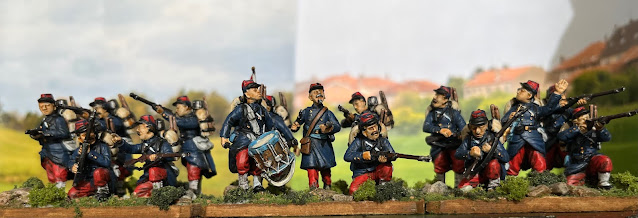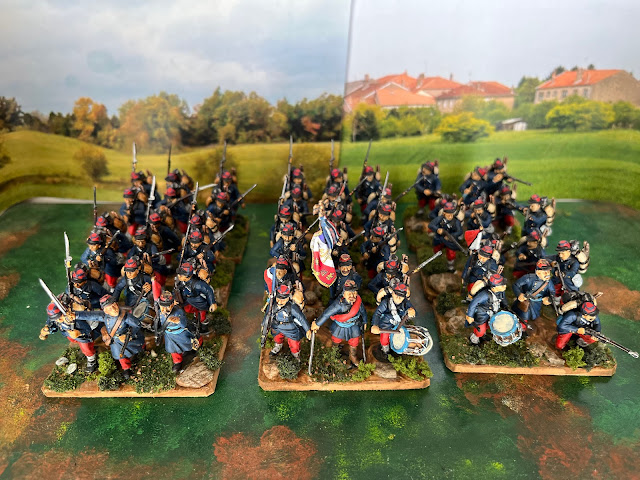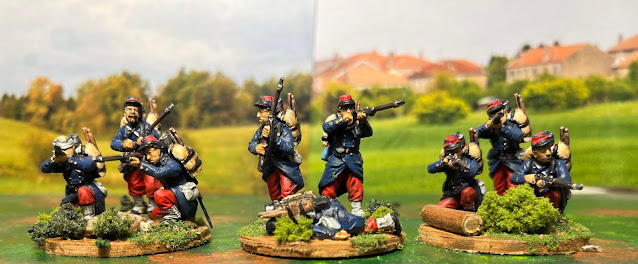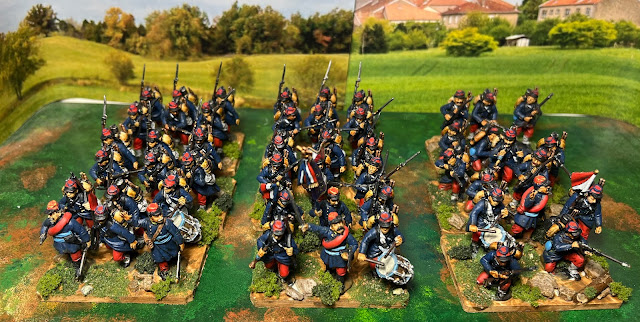The Attack of Michel's Brigade
The cavalry wheeled right, to face south east, anchoring their right flank on the Ederbach, but as they advanced they found that their front was too broad for the narrow gap through which they needed to pass to reach their intended position. The regiments formed close column before proceeding up the slope of the valley. Michel and de la Rochière rode forward to the ridge where Lartigue waited to give them the direction of attack. Moments later the cavalry rode out of the Ederbach valley and wheeled right to face Morsbronn. There, as they came within range of the German rifles for the first time, the familiar clink of their harnesses and the rattle of their sabres in their scabbards were replaced by the sinister ping of bullets striking their steel breastplates.  | Looking towards Moorsbron from the southwest. The heights beyond the town is the ground over which Michel's troopers advanced
|
At first glance the terrain over which Lartigue instructed Michel to charge appeared open and clear, but when the 8th Cuirassiers rode onto the slopes they found that it was totally unsuited for cavalry actions. The entire expanse between the Ederbach ridge and Morsbronn was traversed by rows of trees, stumps that had been cut off at ground level and deep ditches. The ground was otherwise relatively gentle and open, offering the Germans a clear field of fire. The nature of the slope also prevented the remaining French infantry from providing any fire support. As the 8th Cuirassiers attempted to form for the attack a small area of woods constrained their movement. Attempting to get around this obstacle they were struck by rifle fire from the German infantry near the Lansberg Farm and shell fire from the artillery near Gunstett. Unable to complete their deployment unmolested the 8th charged in their disordered state.  | | The constricting terrain on the edge of Morsbron that disrupted the Cuirassiers |
Guilot de la Rochière led his squadrons directly for Morsbronn, from which two companies of the German 32nd Regiment had just emerged. He intended to catch the Germans while they were in the process of forming up. The cavalry rode across the broken ground and got as close as 400 yards to the Germans before the alarm was raised. There was no panic amongst the infantry, who were so confident in their ability to repulse the cavalry that they did not bother to attempt to seek cover in the vineyards or hop fields, nor did they attempt to form squares. Instead they calmly delivered two aimed volleys by command and then independent Schnellfeur, or rapid fire, as the troopers thundered closer. The charging squadrons, unable to manoeuvre in the awkward terrain, rode between the companies and were caught in a deadly crossfire. The two half battalions of 32nd wheeled right and opened fire. Some elements of the 1st and 3rd Squadrons managed to push their way through the skirmishers of the 32nd, but the larger part of the squadrons, now completely out of control, dashed into Morsbronn itself at the gallop. They swept through the narrow streets, between houses occupied by German infantry. Men and horses were shot down as the Cuirassiers desperately sought to find an exit. However, when the troopers reached the opposite side of the village they found their way barred by the barricades erected by two companies Tirailleurs when they occupied the village earlier. Trapped in the confined space by the main bodies of 32nd the Cuirassiers were compelled to turn about under the deadly fire and ride back through the town, exiting through the northern side. There they reformed under fire before charging again, breaking through the hop fields towards Durrenbach where they encountered two companies of the German 80th Regiment. In the few minutes of furious action the 8th Cuirassiers lost 295 officers and men and 275 horses from the 529 that had started the charge. While the 8th Cuirassiers floundered in Morsbronn, Duhesme sent Colonel Waternau's 9th Cuirassiers to the attack. Swinging further to the west than the 8th, the three squadrons of the 9th made for the left of the German line where Captain Küster's 3/11th Pioneers stood. The Pioneers opened fire with Schnellfeur at a range of 300 yards, but they could not halt the cuirassiers and part of Küster's company gave way as the French cavalry swept past their right. The fire of the 32nd drove the troopers further west. Redirecting their charge the troopers of the 9th veered left and entered the main street that ran east-west through the village. This part of the village was occupied by portions of the 94th Regiment that opened a devastating fire. “Here ensued the great slaughter, these poor riders, packed tight in a banked road, were shot point blank by infantry stationed in the gardens overlooking the road and there was no struggle, not an enemy within reach of the cuirassiers...” In the ensuing chaos Waternau had his horse shot from under him, but taking one from a sergeant, attempted to lead the regiment out of the village to the south. Again the barricades foiled the attempt. The troopers swirled in the streets, mingling with trapped portions of the 8th Cuirassiers, desperately seeking escape, but to no avail. Within minutes Waternau was unhorsed again and almost every trooper left in the village was killed, wounded or captured. Of the 400 men who charged, 30 officers and 338 men, plus 366 horses, were lost.  | | Charge of the 9th Cuirassiers by Edouard Detaille, photographed at Musee de 6 Aout in 2018 |
Colonel Tripart's 6th Lancers also headed for the German left. The 8th Company, 32nd wheeled to face their attack and delivered a disciplined volley before opening Schnellfeur. Three officers and 52 troopers fell in the charge. Like the cuirassiers only a handful of lancers succeeded in getting through the German infantry and they flowed around the village with the other French troopers to the south east. Fifty or so troopers from the three regiments, nearly all of their horses injured or blown from their charge, managed to escape from the village and drifted towards the Ederbach stream where they rallied under a captain of the 8th Cuirassiers. There they encountered the three squadrons of Colonel von Henduck's 13th Hussars, formed in column of divisions facing the opposite direction, guarding the extreme left of the German line. When the disorganised muddle of French troopers came within 300 yards of the Hussars, the German troopers wheeled about by division and advanced on the French. Neither side appeared willing to force the issue although the hussars seriously outnumbered the French troopers. The two bodies of cavalry approached each other cautiously and closed to within as little as ten yards before a brief exchange of pistol fire broke out. This was all too much for the exhausted French troopers who turned and attempted to dash back towards their own lines. Pursued hard by von Henduck's Hussars and unable to go back the way they had come, the French cavalry attempted to move south west towards Laubach, but when they found that route to be blocked, they remnant drifted east of Morsbronn dispersing as they went. Michel's Brigade was almost completely destroyed. Of the 1,200 troopers that charged only a handful returned to the lines. The southeastern slopes in front of Morsbronn were littered with the dead and dying, riders and horses. The charge caused only a temporary inconvenience to the German infantry battalions which quickly reformed and prepared to continue their advance. However, the sacrifice of these magnificent cavalry regiments did provide Lartigue the pause he needed to safely extract his infantry. About an hour and a half later the situation for the French had worsened when the German XI and V Corps linked up and the French right was in a state of collapse. In a desperate effort to gain some time to permit the escape of the infantry and artillery MacMahon looked to his cavalry and called on général de division Charles Bonnemains' 2nd Reserve Cavalry Division. Bonnemains' division consisted of two brigades each of two regiments of cuirassiers. The First Brigade, comprising Colonel de Vandoeuvre's 1st Cuirassiers and Colonel Billet's 4th Cuirassiers, was commanded by général de brigade Girard and counted 1,065 troopers in the ranks. The Second Brigade, under général de brigade de Brauer consisted of Colonel Rosetti's 2nd Cuirassiers and Colonel Lafuntsun de Lacarre's 3rd Cuirassiers, and had counted 1,095 men at the commencement of the day. The cuirassiers were posted to the southwest of Froeschwiller in the valley of the Eberbach, a position they had held since daybreak. During the German mid-morning bombardment, the cavalry had been compelled to change positions several times in order to avoid the German shells that overshot the ridge, but at around 1230 the division had finally reformed in its original position in tight column of half regiments. Shortly after this MacMahon had ordered the Girard's Brigade to move to the left bank of the Ederbach, about 400 yards from the Froeschwiller-Morsbronn Road, while de Brauer's remained on the right bank. Around 1500, as the situation on the French right was at its most critical, MacMahon rode up to Girard and said, “You are to charge your first regiment, squadron by squadron...to give confidence to those troops who have been beaten”. Unable to see anything more than a line of skirmishers in front of him Girard asked the Marshal to clarify the purpose of the charge. MacMahon replied that he did not want a serious charge, but rather a series of feint charges that would halt the German advance. “...I just want to save time,” he said. There was no time to reconnoiter and Girard led the brigade forward. He soon discovered that the terrain over which the charge was to be made was every bit as unsuited for cavalry as was the ground over which Michel's troopers had charged earlier. Sloping away some 800 yards to the southeast the ground was crossed with hedges, fences, ditches, small quarries and tree stumps, some of which were chest high and barely visible from a distance. Vineyards, apple orchards and hop fields broke the terrain up further.  | | The terrain over which the cuirassiers charged. Froeschwiler is in the centre in the distance and Elsasshausen is to the left of shot. |
This broken terrain provided excellent firing positions for the German infantry and artillery that were present in considerable force. To the west of Elsasshausen 45 guns were posted, assisted by portions of four XI Corps battalions and elements of three V Corps regiments. Colonel Vandoeuvre's 1st Cuirassiers led the division riding due east to a position approximately 500 yards north of Elsasshausen. Girard had repeated MacMahon's instructions to Vandoeuvre, telling him specifically to avoid any obstacles. The squadrons turned successively and charged. 
Almost immediately they found their path blocked by a ditch and halted under a heavy fire from the German infantry. Unable to cross the ditch the regiment was compelled to retire. As the squadrons returned Girard called forward the 4th Cuirassiers, but before that regiment could arrive MacMahon, who had ridden forward to Girard, ordered that the 1st Cuirassiers should charge again. Holding back the 4th Squadron Girard ordered the other three squadrons to charge. The result of this second charge was as much of a failure as the first and the squadrons returned counting a loss of 65 officers and men While the disorganised 1st retreated Colonel Billet brought the 4th up in close column several hundred yards to the left of the 1st where the ground was less obstructed. The 1st Squadron, led by Captain Billot, galloped up to the ridge line where it deployed into column of platoons. Crossing the paved road the cavalry soon found their front covered by refugees from almost every regiment that had fought on the French right, including a group of cuirassier's from Michel's brigade. The remaining squadrons of the Regiment came up and formed column of platoons about 100 yards east of the road. There they came under an increasing volume of fire and the sound of the bullets on the iron breastplates of the troopers was likened to “the impact of hail on a window pane.” Once the regiment was deployed the Colonel ordered Captain Billot to lead the 1st Squadron to attack some German infantry that were posted in a hop field some 600 yards distant and were directing their fire on the cavalry. The squadron passed 250 yards to the north of the now burning village of Elsasshausen where the ground appeared clearer than that over which Vandoeuvre had charged. The squadron broke into the charge down hill across the slope right up to the hop field. The ground that had appeared clear soon disproved that initial view. The hop poles in the plantation were bound together with iron wire and proved to be an impassable obstacle for the troopers. The charge faltered and many a trooper fell victim to German bullets there. Billot was compelled to turn the squadron back and extract it as best he could. Captain Millas' 2nd Squadron, accompanied by the colonel, followed Billot closely. Millas took his squadron to the left, but the ground there was no more favourable and the attack faltered when the troopers found themselves faced by a vineyard. For a while the cavalrymen rode back and forth, trying desperately to find a way to strike the Germans, but they were cut down by the enemy fire. Millas' arm was carried off by a shell and the senior lieutenant was also wounded. The squadron dashed back beyond Elsasshausen and rallied behind the remaining squadrons. At that point MacMahon rode up and asked that Billet make a more concerted effort to avoid the obstacles that were breaking up the charge. Billet called to Captain Negroni's 4th Squadron “follow me” and set off towards the right. In an attempt to find an unobstructed path he led them through a section of sunken road south that ran from Froeschwiller to Morsbronn. From there Billet discovered a clear stretch of land in the form of a grassy valley that ran towards Woerth. The 2nd platoon soon found a passage out of the sunken road and the rest of the column quickly followed. The 4th Squadron filed into the valley and quickly formed line of battle. Billet gave the word and they set off at the gallop towards the east, although no enemy was in view. The troopers raced forward perhaps 1,000 yards still without sighting any enemy when suddenly the standard bearer, Lieutenant Ginder, called out “there they are” pointing to a group of German skirmishers in an apple orchard 50 yards to the right. Billet swung the attacking line in their direction and in no time the cavalry were amongst the enemy skirmishers, who rapidly fell back on their main line. The fight was short and sharp. Of the six officers of the 4th squadron, four were shot down, while the German main line was not reached. Trapped in terrain broken by trees and hedges, and under fire from all directions the cuirassiers fell back to rally on the ridge. The 5th Squadron had supported the 4th, but also failed to make an impact and retreated to the ridge. There both squadrons joined the regiments of de Brauer's brigade that had been brought across the Ederbach. In its charge the 4th Cuirassiers lost eight officers and 170 men.  | | Colonel Negroni - also credited with the creation of the Negroni cocktail. |
Not convinced that Girard's attack had gained him enough time, MacMahon asked Bonnemains if another effort could be made. Bonnemains replied that he could and gave the order for de Brauer to charge in a column of half regiments. The 2nd Cuirassiers led the way with the 1st and 2nd Squadrons under Chef d'Escadron Corot-Laquiante forming the half regiment in the lead. General Wolff, who had led an infantry attack across this ground earlier, rode forward with them for a short way to give the column direction toward an enemy that was as yet unseen. The 1st Squadron was on the right and the 2nd on the left. When Corot-Laquiante rode onto the flat land northwest of Elsasshausen he turned both squadrons a quarter to the right and prepared to charge the Germans to his front which consisted of a line of skirmishers with heavy lines to their rear, coming up from Woerth. But when the 2nd Squadron began to advance it found its way blocked by an unseen obstacle, a wide ditch lined with apple trees. A number of horses tumbled into the ditch and the advance faltered. On the right the 1st Squadron charged into a narrow gap between a hop field and a grove of low trees, both of which were occupied by German infantry who opened fire at a range of 30 yards. The whole area was quickly swept by fire. Lieutenant-Colonel Boré-Verrier, who had accompanied the two squadrons, quickly saw the futility of the charge and sounded the retreat. The second half regiment, under Chef d'Escadron Lacour, accompanied by Colonel Rosetti, followed the first a few minutes later and met with a similar fate. A few troopers, disconnected from the main body had made for a German gun that was posted in the corner of an orchard. As the troopers approached the gunners abandoned their gun and took shelter behind the trees. Unable to get at their prey, the cuirassiers turned away and the German gunners returned to their piece and blasted them. Hardly any of the 4th Squadron got near the enemy and Rosetti withdrew them from the fight, reforming them near the Gross Wald for a fresh charge. In the few minutes of action the 2nd lost seven officers and 141 men.  | | A rather fanciful depiction of the charge |
Colonel Lafuntsun de Lacarre's 3rd Cuirassiers had formed in squadrons ready to advance. The 1st and 3rd Squadrons were in the front line and the 2nd and 5th to the rear. For nearly half an hour the regiment was held in this position, under a hail of bullets, impassive spectators of the carnage in front of them. When the attack of the 2nd Cuirassiers had clearly failed, de Brauer rode up to Lafuntsun de Lacarre and gave him the direction of advance. Lafuntsun de Lacarre, who was in front of the regiment, raised his sword to lead the charge when a shell tore his head off. The whole of the first line galloped off the field in shock, following the remnants of the 2nd Cuirassiers. The second line held is ground, but was soon withdrawn, at MacMahon's order, and rallied near the woods to the rear, where the remnants of Bonnemains' two horse batteries had taken up their final position. The 3rd Cuirassiers counted a loss of six officers, including all four of the squadron captains, and 34 men. While the cavalry failed to drive off the German infantry, it did have some measure of success in that it delayed their advance, if only momentarily. Primary sources, German and French official histories.
|



















































